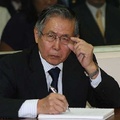After reading former president Fujimori’s guilty verdict and the debates that ensued, it seems important that we avoid a knee-jerk defense of the verdict or a quick rush to discredit it.
If one searches for “solid evidence” in the verdict (in the same manner that Federico Salazar or José Luis Sardón did in their last columns), in which Fujimori created and directed the Grupo Colina, or that the former president personally ordered the massacres at Barrios Altos and La Cantuta; in effect, you are not going to find such evidence. If one reads the verdict searching for direct links between Fujimori and those crimes, it seems to me, you will find a document with large gaps and reckless inferences.
Nevertheless, the primary reasoning that is found in the verdict does not follow this path. It is very solid if one follows the verdict's logic, which, simply put, goes something like this: Fujimori governed by concentrating power in authoritative fashion. Developing a strategy against subversive types was one of his primary concerns as president; this strategy gave excessive leeway to intelligence agencies, particularly to those under the auspices of Montesinos and Hermoza. Montesinos designed a strategy with a “public” component (the so-called “soldier-friend," respect for human rights, etc.) and a secret component, one with chosen assassinations, in charge of the Grupo Colina.
The group’s functioning required a large organized deployment inside the ranks of the army, which could not have been kept from the president. The group operated between August 1991 and the end of 1992, and carried out eleven operations, murdering at least 49 persons. All of these cases were of public knowledge, and Fujimori’s attitude was always that of defending those responsible, while obfuscating and distorting the facts. His public actions reflected a person who had endorsed those operations, which would not have occured without his blessings, and which demonstrate that these events were part of an approved strategy, by him as the chief. In other words, it is not a question of whether or not Fujimori had ordered the murders in Barrios Altos and La Cantuta; rather, it is that those murders were part of an approved strategy, one that was endorsed and defended by Fujimori.
In order for Fujimori’s plea of innocence to have some credibility, he should at least pointed the finger of blame at Montesinos, Hermoza, or Salazar Monroe. He chose not follow this path. His own lawyer, César Nakazaki, also represented Hermoza and Salazar Monroe (as has been mentioned by Ricardo Vásquez and Enrique Zileri). It also was not convenient for Fujimori to “air the dirty laundry” or initiate a war of accusations. Another strategy should have been, as suggested with great cynicism (shared by many supporters of Fujimori) on more than one occasion by Uri Ben Schmuel in the newspaper La Razón, that “…instead of adding and subtracting months or years to a prison sentence, Fujimori should have said what everyone else was thinking but kept to themselves rather hypocritcally: to attain peace one has to pay with blood.” Such political justification, however, implied a clear recognition of Fujimori's criminal responsibility.
*Article taken from Virtù e Fortuna from Martín Tanaka’s blog, with permission of the author for publication on the Discover Nikkei website (Agreement San Marcos Foundation). It was also published in the newspaper Diario La República, newspaper of Lima, on Tuesday, April 14, 2009.
© 2009 Martín Tanaka




